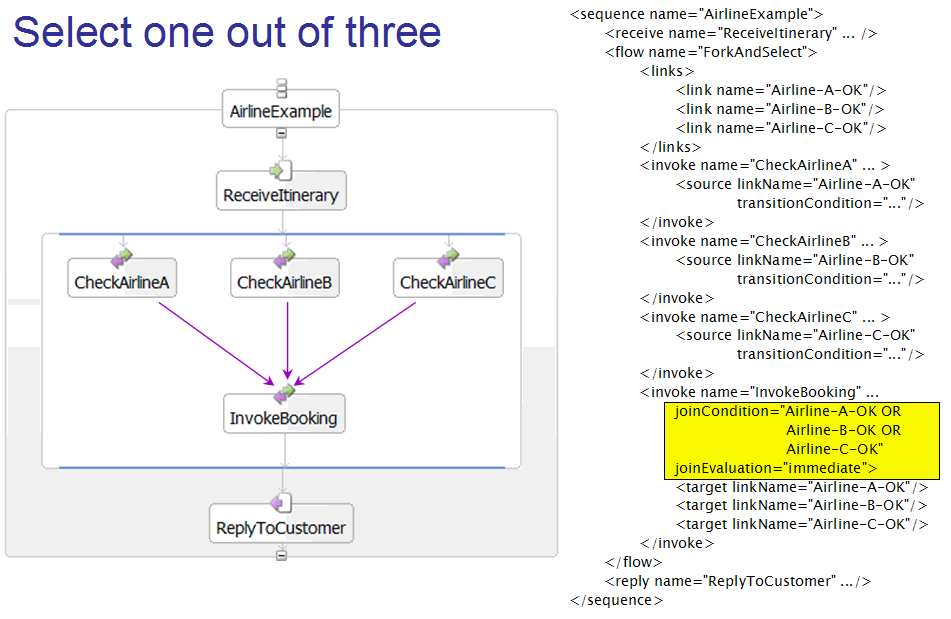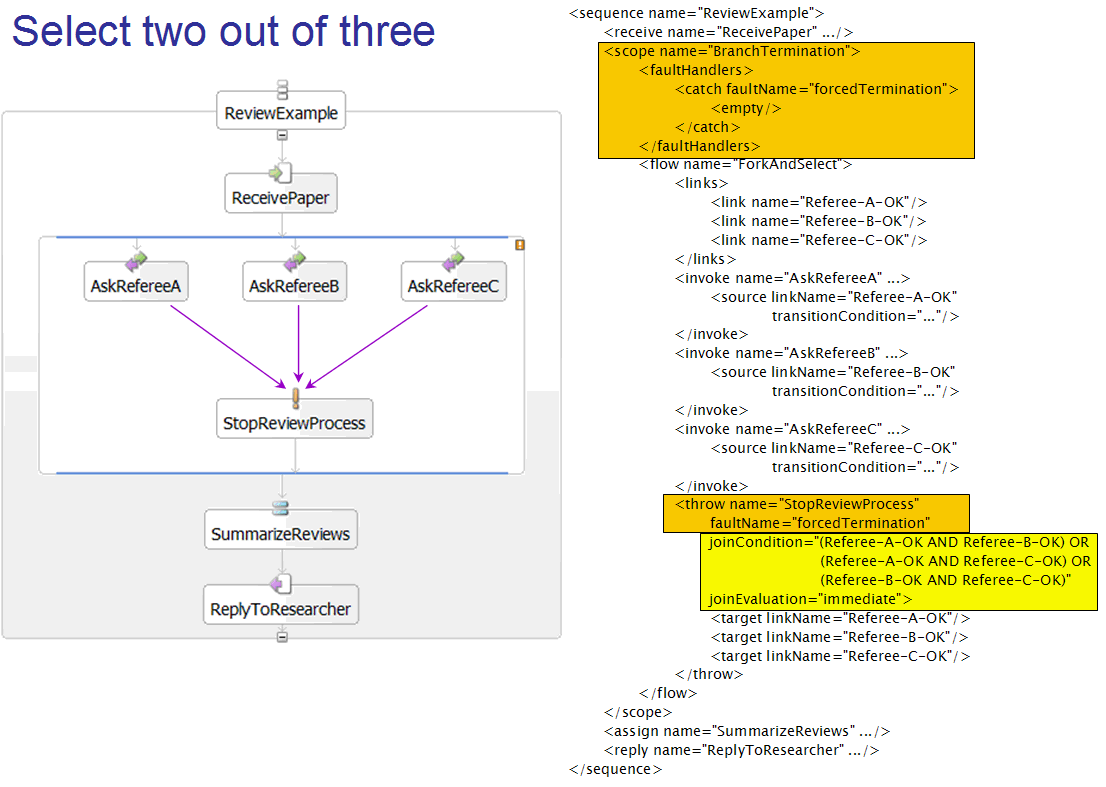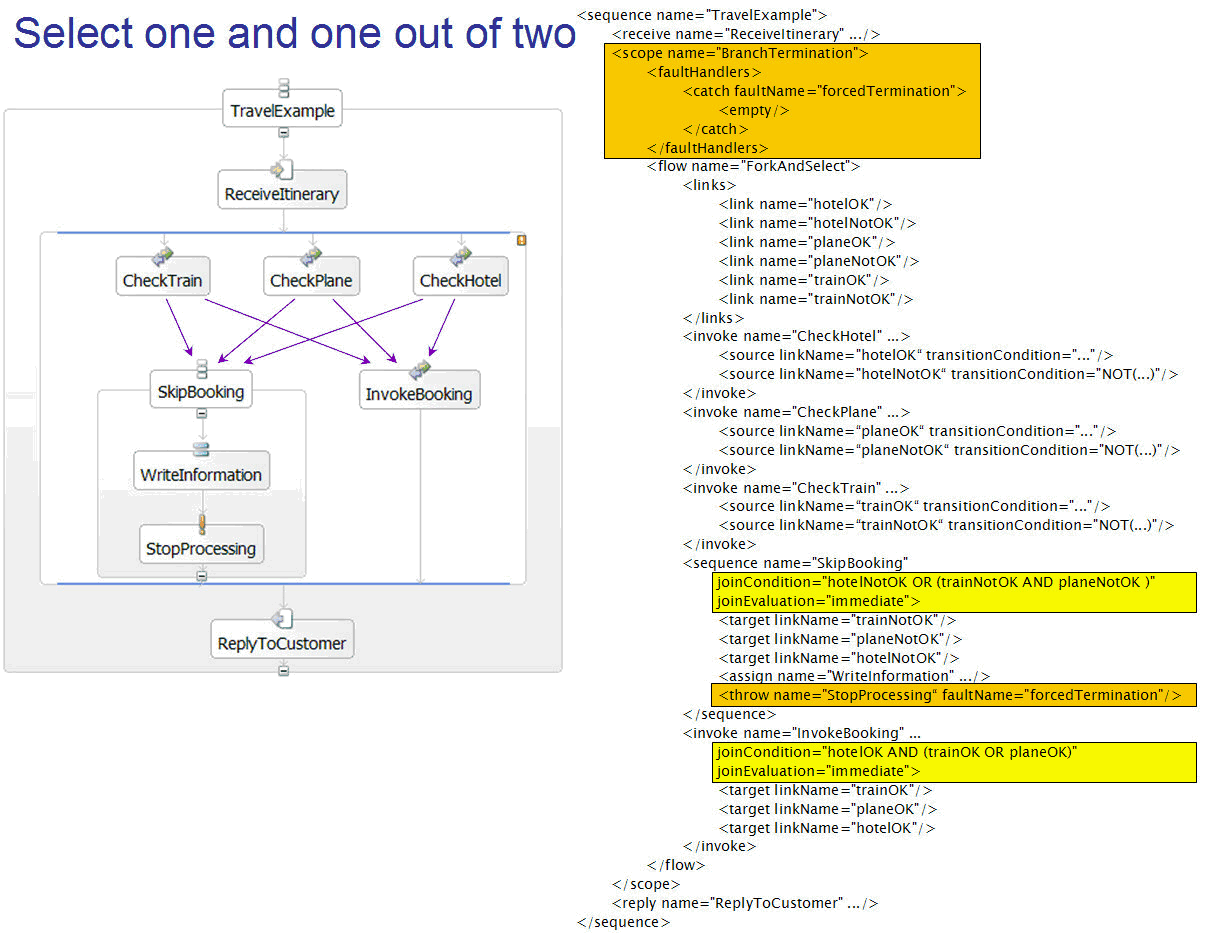From: Axel Martens [mailto:amarten@us.ibm.com]
Sent: Mittwoch, 1. September 2004 19:25
To: Trickovic, Ivana
Cc: 'alex.yiu@oracle.com'; 'edwink@collaxa.com'; 'satisht@microsoft.com'; 'wsbpel@lists.oasis-open.org'
Subject: RE: [wsbpel] Issue 6 - Rough draft of proposal for vote
Dear all:
I'd like to participate in your discussion with a proposal that
comes with minimal changes to the current BPEL specification but
is able to handle the mentioned use cases, and even more.
First, I'd like to introduce myself. I am a post-doc researcher at
IBM Watson, working in the group of Paco Curbera. In my PhD thesis
I have dealt with Web service based business processes and Petri
nets. Hence, I know the discussion on the mismatch between BPEL
and the workflow pattern à la van der Aalst quite well.
I completely agree on searching for a general solution to the
request of issue 6 rather than fixing distinguished cases. The
problem (or restriction) of BPEL is that you can't enable or
disable an activity easily w.r.t. to the complex context, like you
can do modeling with Petri nets or related methods. The deferred
evaluation of the join condition (all incoming links has to be
signaled first) is one of the mayor reasons for it. Hence, our
group proposes to allow an immediate evaluation of the join
condition, too. This feature was already covered by IBM's Flow
Definition Language (FDL) and Web Service Flow Language (WSFL).
The next paragraph explains the proposed change to syntax and
semantics. Afterwards I show three examples to demonstrate the
expressive power of this changes.
Syntax & semantics:
The changes to syntax are minimal. Each activity gets a new
standard attribute "joinEvaluation" - of course, this attribute
has only influence on activities that are target of at least two
links. The attribute can have the values "deferred" (the default
value) and "immediate".
As a kind of syntactical sugar, each flow or the whole process
might redefine the default value for all its child activities
through the additional attribute "defaultJoinEvaluation". But, we
do not insist on this change.
In case, the attribute was set to "deferred", the join behavior
stays untouched. If the attribute was set to "immediate", the join
condition is evaluated each time one of the incoming links has
changed its value. Some examples:
"true" and "yet undefined" yields "yet undefined"
"false" and "yet undefined" yields "false"
"true" or "yet undefined" yields "true"
"false" or "yet undefined" yields "yet undefined"
This evaluation may yield "yet undefined", than nothing happens.
If the join condition could be evaluated to "true" or "false", the
activity is executed or skipped, and further changes to the link
values are ignored.
Because links are not allowed to cross the borders of a while loop
and each time a while loop is entered, its internal link value
should be cleared, there can't be any confusion.
Examples:
This changes together with the already existing concepts of scope
and fault handling allow an strait forward mapping of the missing
pattern.
One-out-of-Many
First, we take a look on a selection of one result out of three,
where the not chosen alternatives are allowed to finish normally.
The following figure shows the example of contacting three
airlines and booking the first available (for reasons of clarity,
the bpel-code is not fully specified).

Because of the immediate evaluation of the join condition, the
activity "InvokeBooking" is started directly after the termination
of one preceding activity. Whereas the flow is exited only if all
its child activities are terminated. In case, the customer should
be informed as soon as possible, the reply activity should be
moved into the flow in sequence to "InvokeBooking".
N-out-of-M
The second example shows two new aspects. First, the join requires
at least two of the three referees to have finished the review.
This is done by a modified join condition. Second, after two
results are available, still running activities of the flow are
explicitly terminated. This is modeled by help of a scope around
the flow with an empty fault handler that catches the
"forcedTemination" fault.

These mechanisms already exit. Hence, no further changes to the
language itself are necessary. Of course, a user should be
supported, e.g. by generating such structures automatically on
demand, but this is a task of tooling rather than language design.
More complex relations
Finally, the join condition can specify precisely which
combination of link values is needed to proceed, instead of just
the number. The last figure shows an example employing this
feature: For booking a trip, it is necessary to find an available
hotel and at least on kind of transportation.

This example mixes all concepts. In case, no hotel or no
transportation is available, an information for the customer is
generated ("assign") and the flow is terminated ("throw").
Otherwise, the trip is booked ("InvokeBooking") and still running
activities are allowed to terminate on their own before the
customer is informed.
Summary
A minimal change to BPEL's syntax and an easy to implement change
to its operational semantics enrich the expressive power
enormously, such that more useful modeling pattern could be mapped
into this language. To increase the convenience of usage, tools
may provide predefined macros or generate necessary structures
automatically on demand.
Regards, Axel.
----------------------------------------
Axel Martens
Post Doc Researcher
Component Systems Group
IBM TJ Watson Research Center
Hawthorne, NY (USA)
Phone: (914) 784-7480
E-mail: amarten@us.ibm.com
| "Trickovic, Ivana"
<ivana.trickovic@sap.com>
09/01/2004 10:32 AM |
|
Alex,
Regarding the proposed semantics: Would you elaborate how the fault (bpws:earlyCompletionFault) will be signaled to other incomplete flow activities? Those activities are enclosed within the flow activity. If I understand the fault handling model correctly there is no possibility to communicate faults to nested activities/scopes except canceling the enclosing activity (in this case, the flow activity).
Regards,
Ivana
-----Original Message-----
From: Alex
Yiu [mailto:alex.yiu@oracle.com]
Sent: Mittwoch, 1. September 2004
04:28
To: Satish Thatte
Cc: edwink@collaxa.com;
wsbpel@lists.oasis-open.org; Alex Yiu
Subject: Re: [wsbpel] Issue 6
- Rough draft of proposal for vote
Hi, Yaron
and others,
I agree with the concern of Edwin and Satish. We should
define a general mechansim to express early completion condition. Then, define
the "orJoin" attribute or other syntax as a macro/special syntax short
cut.
If you guys don't mind, I can supplement some alternative ideas to
this issue. I am in the thinking-out-loud mode again. That means, I need to
verify whether this idea makes sense to other people at Oracle. [ But,
as Ron said, this thinking-out-loud mode has worked quite well for me in the
past. ;-) ]
We should allow a <completeCondition> subelement
attached to parallel-flow-starter activity (e.g. <flow> or future
potential parallel <forEach>).
Syntax of
completeCondition:
It has two forms:
(1)
<completeCondition>a_boolean_expr</completeCondition>
(2)
<completeCondition minFlow="a_number" />
... or ...
<completeCondition
countMinFlow="yes">a_number_expr</completeCondition>
The
first form is the most generic form of completion condition.
The second
form provides a convienent shorthand to achieves the N out of M semantics.
The suggested orJoin="yes" is equivalent to:
<flow>
<completeCondition minFlow="1" />
...
</flow>
Semantics of
completeCondition:
The complete condition will be evaluated at the
completion of each flow. If the condition is true, a standard fault
bpws:earlyCompletionFault will be signaled to other incomplete flow
activities. Each incomplete flow activity can potentially be compensated if
each flow is a scope activity. (Potentially, we can add static analysis to
enforce that when a completionCondition is used in <flow>, <scope>
must be used as activities within the flow.)
The completeCondition
itself is executed in the same scope context of the <flow> activity.
[ And, the completeCondition should be executed serially, to avoid
racing condition among flows (?)]
I hope this rough draft of ideas
serves as a good base of discussion for this
issue.
Thanks!
Regards,
Alex
Yiu
Satish Thatte wrote:
I echo Edwin's second question. Yaron, your
proposal clearly doesn't address the intent of 6. It seems too narrow to
just address this corner case of completion of one among many (corner case
from my perspective).
Satish
From: Edwin Khodabakchian [mailto:edwink@collaxa.com]
Sent: Friday, August 27, 2004 5:38 PM
To: wsbpel@lists.oasis-open.org
Subject: RE: [wsbpel] Issue 6 - Rough draft of proposal for vote
Hi Yaron,
2 questions:
1) are we sure that termination is the desired behavior for the non completed activity?
2) what happens if the join rule is: "the first search result which is non empty or includes at least 3 entries with more than 85% accuracy"? The point here is that a lot of join patterns might have logic in them. I know that in the past we talked about having something like <break> for flow. (This is something that a lot of our customers are asking us and might address the same us case is a more flexible way specially if the <break> can be configure to tell the engine to compensate or terminate).
Best,
Edwin